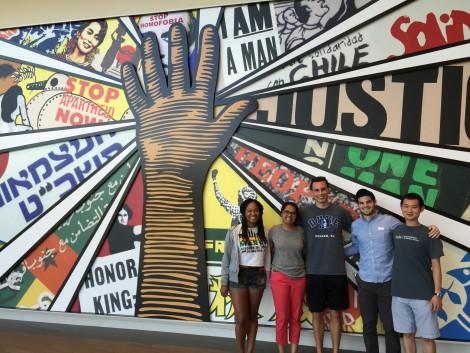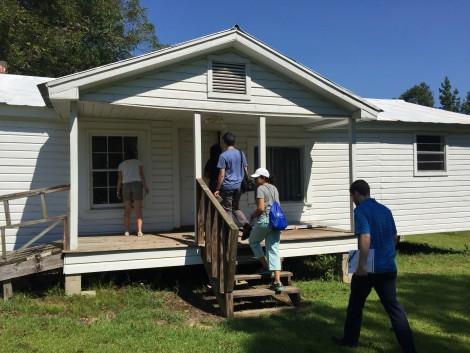

We are finally here. After weeks of anticipation, the first few days of the Environmental Justice Community Research Project have been filled with a whirlwind of events. We spent weeks before we set off for Lowndes County, Alabama, trying to become acquainted with our destination. We read Bloody Lowndes, a book that describes the County’s history of activism during the Civil Rights Movement, and a UN report on access to water and sanitation that includes Lowndes County. We explored material provided by the Equal Justice Initiative that focused on lynching in America and the slave trade in Montgomery. However, walking through Lowndes County and interacting with community members proved that immersive experience is sometimes the best form of education.
Over our two-week trip, we will be immersed in history the Civil Rights Movement in Lowndes County and participate in research that could promote real change in the area. Yesterday, we began both processes.
Our day started with driving along the Selma to Montgomery National Historic Trail. We were on our way to meet Catherine Flowers, director and founder of the Alabama Center for Rural Enterprise (ACRE). In order to get started on our research, Ms. Flowers introduced us to community activists who are long-time residents of Lowndes County and who will facilitate our access to community members during the survey process.

We then met John Jackson, former White Hall Mayor of 30 years, who showed us a few historical landmarks to help us become acquainted with his home county. Mr. Jackson helped organize the Lowndes County Freedom Organization and Lowndes County Black Panther Party. He is rich in historical knowledge and brought all of our readings to life. With Mr. Jackson in the lead, we visited the SNCC Freedom House Complex, which consists of the Jackson Family’s original home turned SNCC Freedom House, a school for African American children, and the Jackson Brothers General Store. We heard personal accounts from Mr. Jackson of what it was like growing up afraid during a time of violence. As a young boy, he didn’t believe that the way his community was treated was unjust, but as he got older, he began to understand that his community deserved better, hence the birth of his activism. Decades later, he still continues with the fight and carries the hope that our country is capable of
The most powerful part of the day was hearing the personal narratives from the community activists and leaders. Mr. Jackson spoke of how history is repeating itself in today’s day and age to wake us all up again. Between present day police brutality and a sheriff shooting that occurred in Lowndes County during the Civil Rights Movement, and the Charleston Church Shooting harkening the Sixteenth Street Baptist Church bombing–the fight for justice still rages at full force in 2015. Despite the continued violence and hate crimes, we must continue to resist, just as Mr. Jackson has been since he was a young boy fighting for equality and power in the Jim Crow South.

Now, it is time for our generation to join the fight for equality and to end hatred through education. As Coretta Scott King so aptly put it, “Freedom is never really won. You earn it and win it every generation.” So, even though we are just a few days in, I am convinced that this project will be an amazing learning experience. My major goal at this point is to be a sponge and soak up as much history, knowledge, and experiences that I can. I am looking forward to the rest of the time that we have here and the change that we will hopefully see in the future.